namdhari world
Main menu:
- Home Page
- Kuka Faith
- History
- Sikh Gurus
- Namdhari Gurus
- Freedom Fighter - Satguru Ram Singh Ji
- Warrior of Peace
- Non-Cooperation Movement page 1
- Non-Cooperation Movment page 2
- Kuka Postal Service
- No Trial
- Battle for recognition as part of India's struggle for freedom
- Plaque at Ludhiana Railway Station
- Ram Singh Kuka by G.K.Venkateshamurthy
- Social Reforms by Satguru Ram Singh Ji
- Birth of Sant Khalsa
- Kuka Movement - by Film division of Government of India
- KUKA LEHAR - India's first war for independance (1856)
- Satguru Jagjit Singh Ji
- Contradictions
- Historical Quotes
- Vaisakhi - 1699
- Gurmukhi Script
- Sikh Women
- Knowlegde Bank
- Connections
- Places to visit
- Resources
- Music World
- Calendar
- Sports
- ETC...
Landmarks in Sri Bhaini Sahib
Places to visit
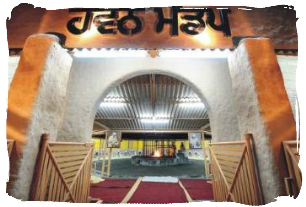
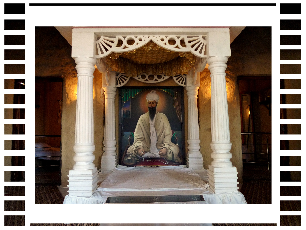
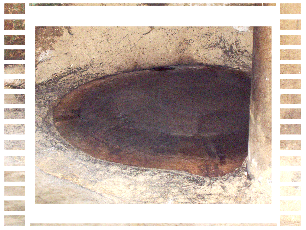
Havan Mandap - The Fire altter
Next to the Ram Sarovar is the almost circular building called the Havan Mandap. This is used for reading of paaths and havan yugs. Since 1937, over the years several lakhs of paaths and havans have been performed here. eg in Feburary of 2010, continous recitation of 1.25 lakh "Chandi Di Vaar" Paath and Havan yags took place. More recently continous Akhand Paaths of Sri Adi Guru Granth Sahib Ji and sardharan Paaths were completed from 15 DEcember 2011 to 1 January 2012. A total of 202 Akhand Paaths were done.
All activity in the Havan Mandap is carefully controlled and it made sure that strict marayada is observed. As such it is the holiest of places.
Assan in Ram Mandir
The magnificent round building of Ram Mandir was constructed, with the blessing of Satguru Jagjit Singh Ji in 2007. On this site Satguru Ram Singh Ji had his residence. The present day Ram Mandir houses a museum having a model of the original building and some personal possessions of Satguru Ram Singh Ji.
Amar loh and Sada Vaart Langar:
The imperishable Iron plate for making chapattis was installed by Satguru Ram Singh Ji in 1861. This langar (a 24/7 communial kitchen) was started by Satguru Ram Singh Ji in 1813 and is operational till today. Each morning sevadars while maintaining the proper Such Sodh marayada and receiting Nam-simran, prepare the langar which is then distributed all day. During the period of Satguru Hari Singh Ji , it served food to thousands of famine stricken people in 1899.
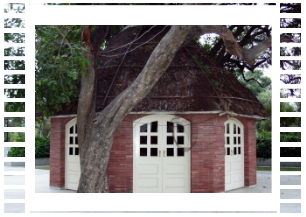
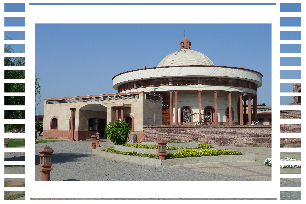
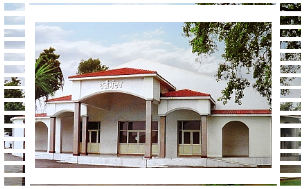
Goal Mandir - The Round temple. Sri Satguru Pratap singh ji breathed his last at this place.
Ram Mandir & Police post
The magnificent round building of Ram Mandir was constructed, with the blessing of Satguru Jagjit Singh Ji in 2007. On his return to Raaian in 1806, Satguru Ram Singh Ji settled in Sri Bhaini Sahib on a plot donated by Bhai Lena Singh. This place became an important landmark in Namdhari history. Satguru Ram Singh Ji resided here till his deportation in January of 1872. The Kuka Laher also flourished at this site. On 19 January 1872, the whole site was searched on orders of the DC of Ludhiana, and a permanent police post was stationed at the Ram Mandir. Satguru Hari Singh Ji maintained Sri Bhaini Sahib while under utmost hardship and survillance (by the British).
Hari Mandir
On the west of the Ram Sarovar is the building called HARI MANDIR. In 1906, at the top of this site, Satguru Hari Singh Ji was cremated.Satguru Partap Singh Ji construsted the Hari Mandir in 1931. It has undergone design changes and gradual modifications. Today this building is used for the daily Nam-simran, Asa de Vaar, and evening kirtan. It is used for sangeet gatherings, marriages and Paath de bhogs. On one side of this building is the historic Banyan tree planted by Sri Satguru Ram Singh Ji.
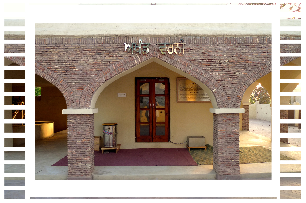
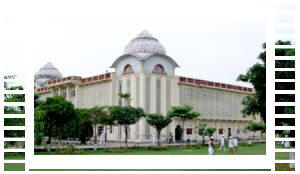
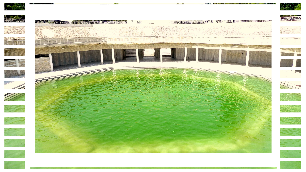
Akhand Varni
Previously this location was earlier known as Shaheedi Bunga. To escape the atrocities of British rulers, many freedom fighters of Babbar Akali Movement, Congress Party amongst others, including Bhagwan Singh Arhbungi, Rattan Singh, Master Mota Singh, and Kishan Singh (father of shaheed Bishan Singh) came to Sri Bhaini Sahib. They took refuge here and seek guidance from Satguru Partap Singh Ji. In 1924, Mata Bhupinder Kaur ji was cremated here. Sometime later a well was dug and in 1934, Satguru Partap Singh Ji started the Akhand Varni ... the non-stop recitation of Nam Simran, which contiues even today..
Guru Nanak Sad Bhawan Mandir.
The largest building in Sri Bhaini Sahib. Satguru Jagjit Singh Ji constructed this building on this place where the historic Brotherhood Conference of various sects having faith in Guru Nanak Dev ji took place in 1934. This important Sri Guru Nanak sarab Sapardaye gathering was organised by Sri Satguru Partap Singh Ji. It was an engineering feat and the largest building of its kind in Asia at its time of construction. It is also known as Pratap Mandhir.
Ram Sarovar - The sacred tank
Sri Satguru Ram Singh Ji discovered and laid the foundation of this legendry Holy Tank (Sarovar). In treta yug, Sri Ram Chandar Ji Maharaj performed havan at this place. During an exvacation, a triangular havan-kund and pieces of coal were found at this site. Satguru Ram Singh Ji named it 'Ram Sar' after the name of Lord Rama and sermonised those who shall take a dip in it will benefits equal to visiting 68 tiraths (pilgrimages). Therafter the sarovar was maintained by Satguru Hari Singh Ji and Satguru Partap Singh Ji. Sri Satguru Jagjit Singh Ji reconstructed it as a modern architectural marvel and maintained its sub-soil ground water (Sodh da jal).
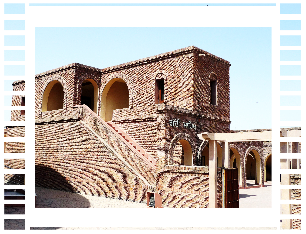
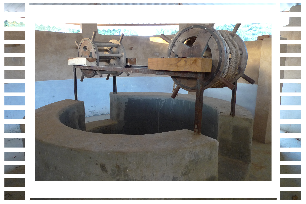
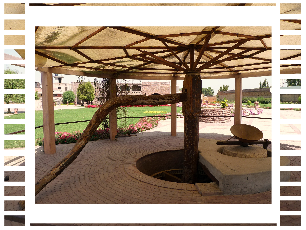
Gaddi Sahib or the Sacred Throne is situated between the Ram mandir and Sadh Vart langar place. This building was the residence of Satguru Hari Singh Ji and later of Mata Bhupinder Kaur Ji. Today the ground floor houses the Sri Satguru Jagjit Singh Ji Library.
Historic Well
This Well is located west of the Ram Sarovar. This Well was dug in 1926 AD with the permission of Satguru Partap Singh Ji especially for the students of the Vidalaya (school) established in 1924 AD. At this historic well Sri Satguru Jagjit Singh Ji after gracing the Gur-gaddi, during the annual Hola Mahallas and Jap Prayogs, changed guise, concealed his identity and fetched water from the well for hours for bathing the Sadh Sangat.
The Old Mill
This mill was made during the days of Satguru Hari Singh Ji. This was necessary because of the rapid increase of the population travelling to Sri Bhaini Sahib. This mill was construsted by Sant Thaker Singh Bhante. It was completed in ten days and on 28 Dec 1895, the mill was operational. In 1905, the police post was shifted nearer to the mill. By the order of the DC of Ludhiana the mill was uplifted and put next to the road leading to Akal Bunga. After 104 years, Satguru Jagjit Singh Ji relocated the mill to its original site, where it stays today.
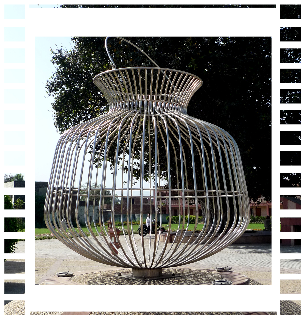
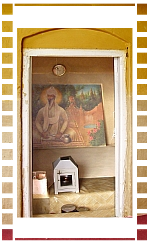
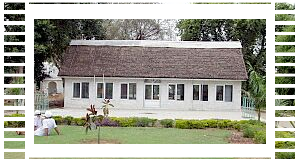
Steel Garva
A very new addition to the Ram Mandhir complex, this Steel Garva is a potent symbol and reminder of the Such Sodh tradition and the recitation of Nam & Bani instilled by all Gurus. This marayada (discipline) was re-enforced by Satguru Ram Singh Ji after Sikhs lost their spiritual goals.
The Akal Bunga:
Bhai Lena Singh donated this piece of land to Satguru Ram Singh Ji. Here a mud room was constructed. Inside a raised platform, surrounded by water was made. On this platform Satguru Ram Singh Ji meditated for long periods. A similar platform was also made outside this room. In 1872, for the causes of cow protection and freedom from imperial rule, Sardar Hira Singh and his jatha departed to Malerkotla. Satguru Jagjit Singh Ji has made all necessary effort to preserve the place of meditation of Satguru Ram Singh Ji.
The Tap Asthan - or place of mediation. This is the place where Satguru Partap Singh Ji meditated for long periods. The mortal remains of Satguru Partap Singh Ji were consigned to flames on the eastern side of this building. Later Satguru Jagjit Singh Ji too used to meditate here.
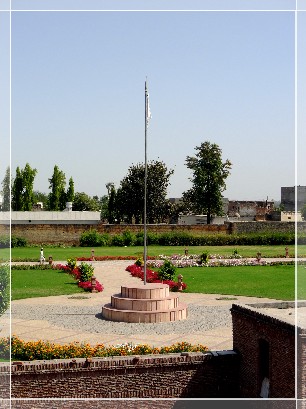
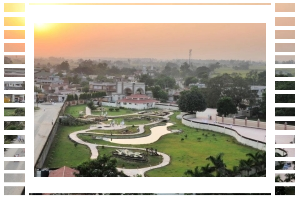
Nishan Sahib:
In the area of the Ram Mandir is the Nishan Sahib. On this site, on 12 April 1857, Satguru Ram Singh Ji rekindled the spirit of the khalsa by administering khandy-bhatay's Amrit to 5 sikhs. It is also the site from where the KUKA ANDOLAN movement was started by Satguru Ram Singh. On 14 April 2007 Satguru Jagjit Singh ji hoisted the white flag to mark the 150yr annivarsary of the KUKA ANDOLAN movement.
Sri Satguru Ram Singh Ji Miniature Theme Park.
In 2011, Sri Satguru Jagjit Singh Ji inaugurated the opening of this Miniature Theme Park. The park is made up of models of important places where Sri Satguru Ram Singh Ji and his subas were detained after the deportation in January 1872.
Bhagwali Khoti:
In 1898, Mata Jeewan Kaur Ji (Mata ji - Satguru Partap Singh Ji) seeked blessings of Satguru Hari Singh Ji and instructed Sant Sewa Singh ji to construct a complex of rooms west of the Ram Sarovar. On this site Satguru Hari Singh Ji, Satguru Partap Singh Ji and Satguru Jagjit Singh Ji meditated and eventually made it their residence.